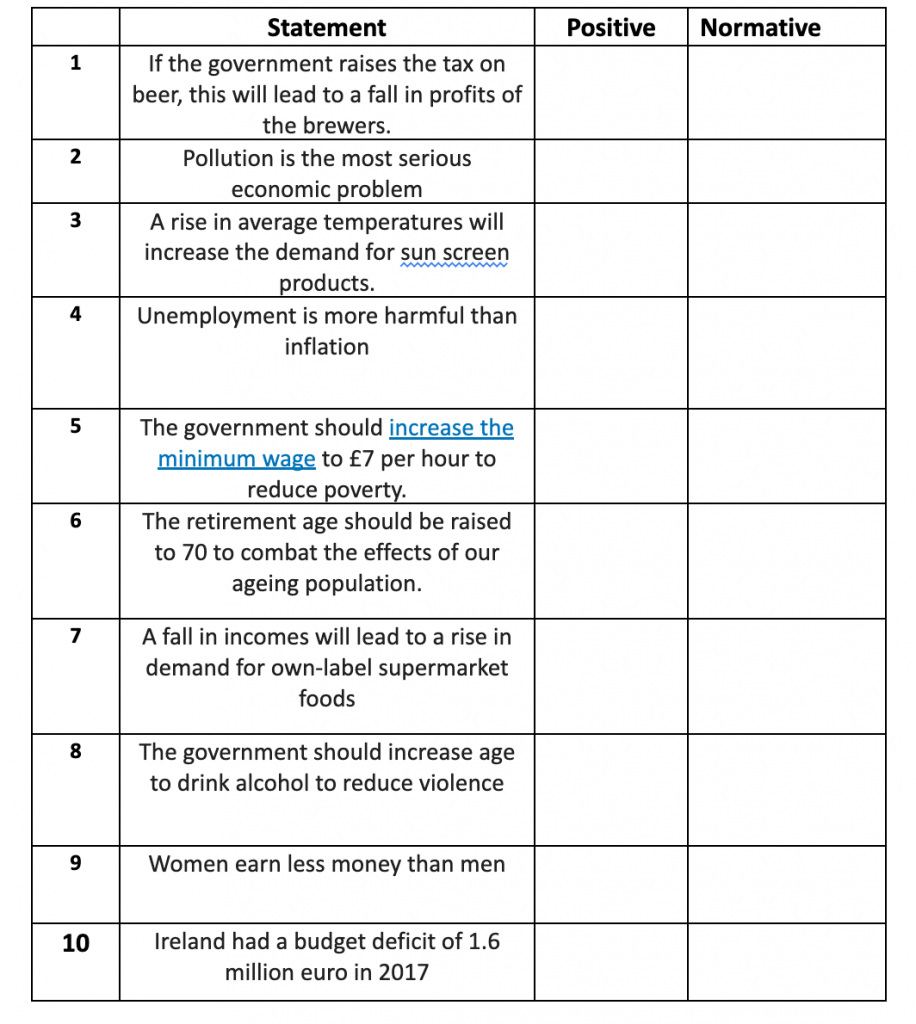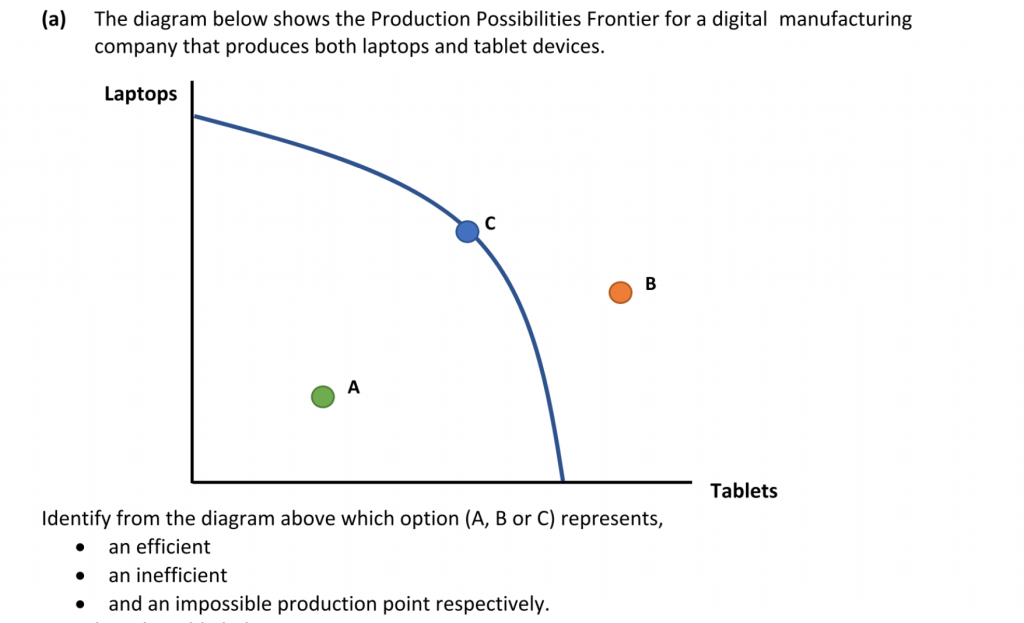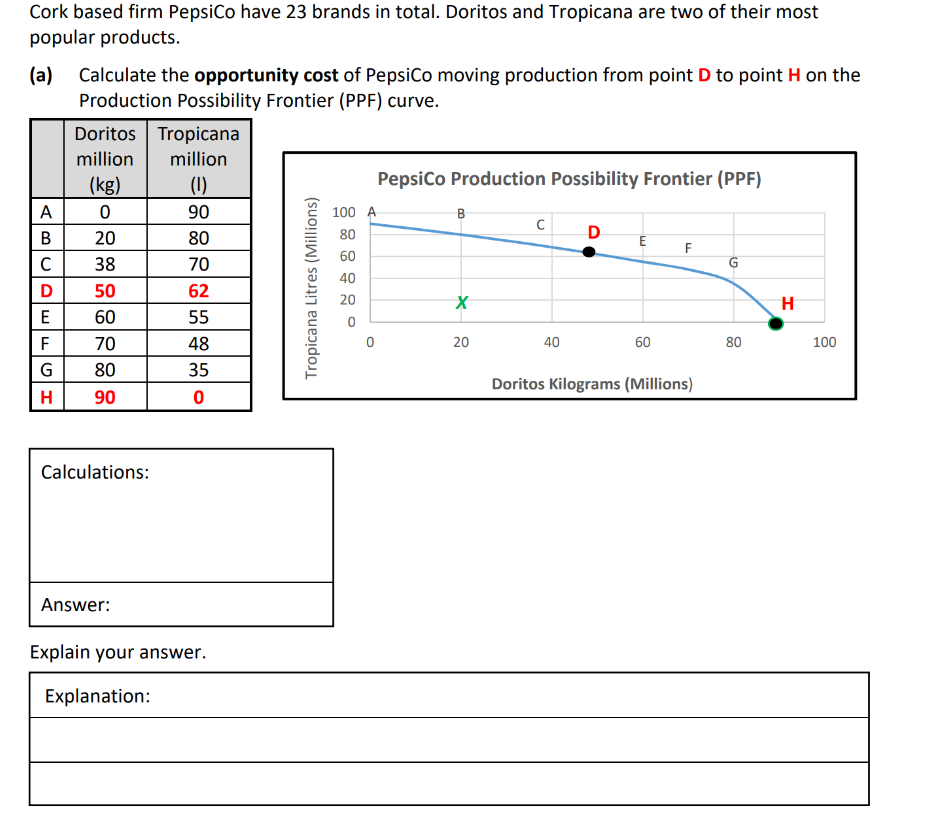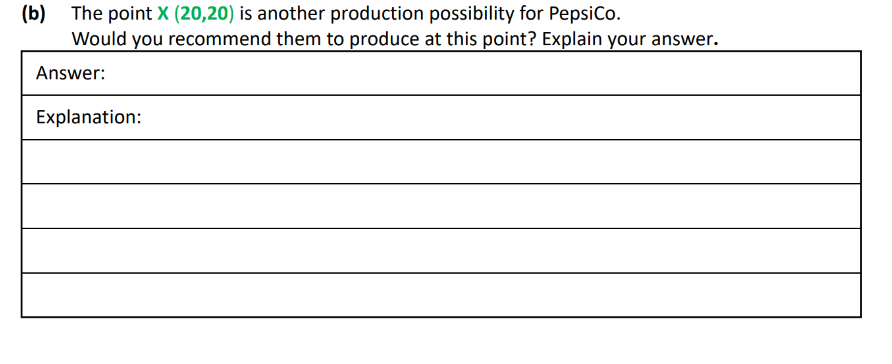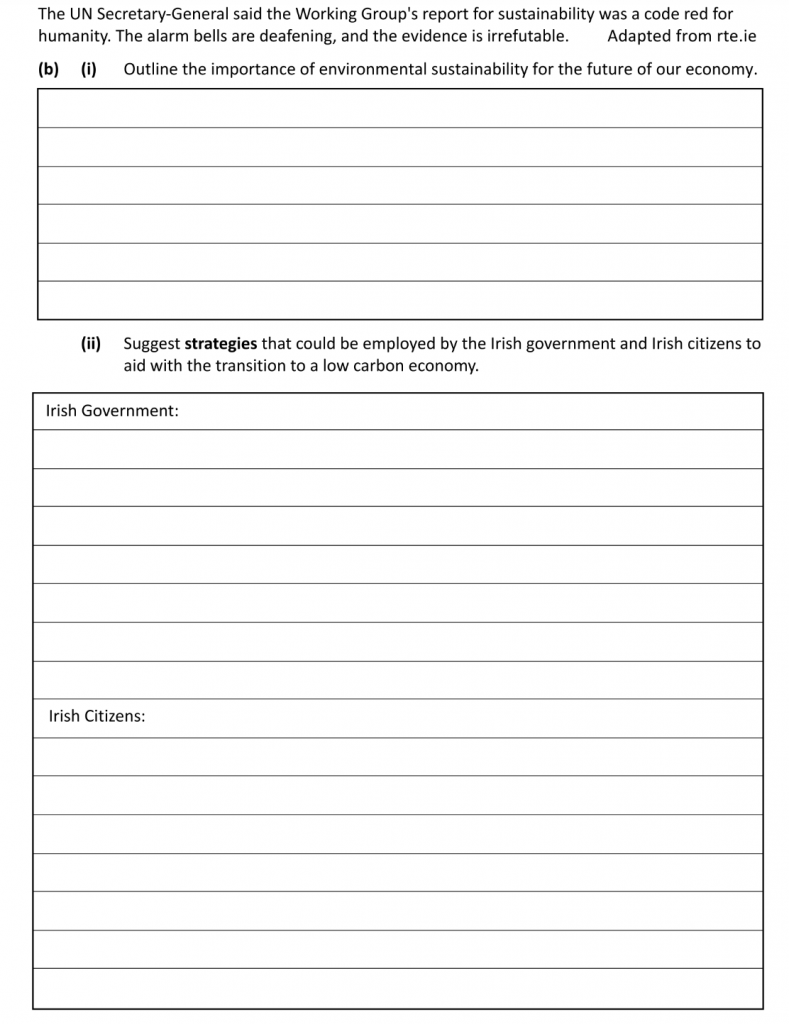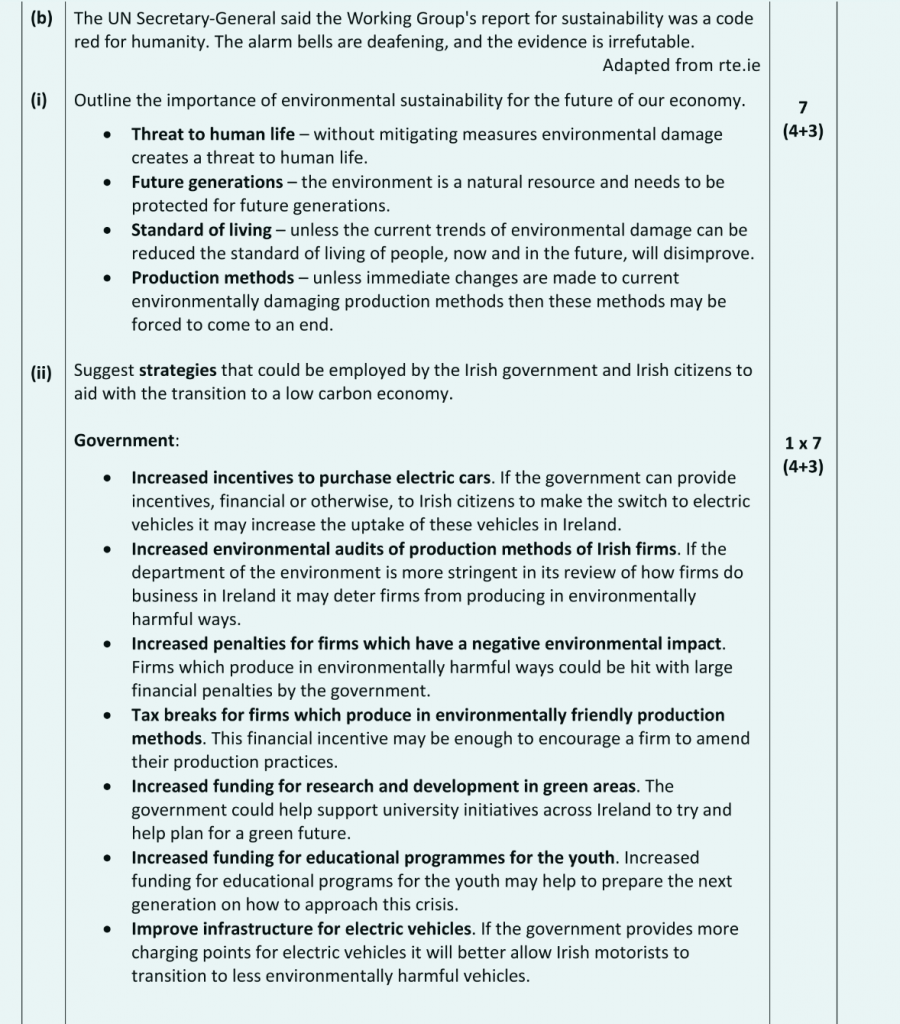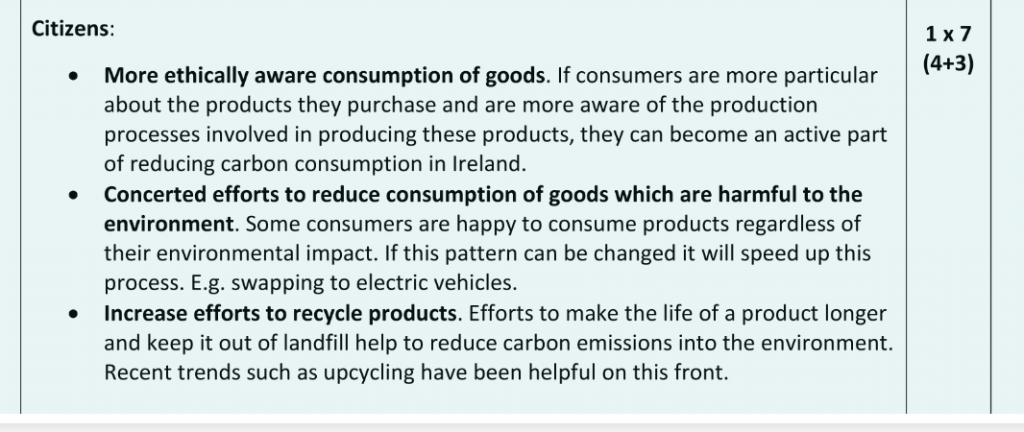STRAND 1: WHAT IS ECONOMICS ABOUT?
- 1.1 Economics as a way of thinking
- 1.2 The economic concepts of scarcity and choice
- 1.3 Economic, social and environmental sustainability
1.1 Economics as a way of thinking
Method of Economic Analysis: Positive V. Normative Economics
Deductive method of reasoning in economics consists of reasoning from the general to the particular. The economist proves that if a law is true for all cases then it must be true for a particular case.
Inductive method draws conclusions from the known facts of economic life e.g. economists examining the sales graph of a good when price is raised or lowered to see if behaves according to the normal law of demand.
Positive statements: something that can be shown to be true or false – by observing real world events.
A normative statement involves making a value judgement or expression of an opinion about what ought to be true.
Activity
- How reliable is the statistic that North Korea’s unemployment rate is 0%
- How do Economists know what is ‘true’?
1.2 The economic concepts of scarcity and choice
THE ECONOMIC PROBLEM
What is the study of economics all about? The central purpose of economic activity is to combine resources in order to produce output that will meet our needs and wants. Resources are scarce, and wants are infinite. So we have a problem – the basic economic problem. These videos explain the basic concepts of economics: scarcity and choice.
SCARCITY– FOP’s ARE FINITE AND WANTS INFINITE
Needs, wants and resources: We need some things just to stay alive – including water, food and warmth. But our wants are never-ending (infinite).
Resources: used to produce these goods and services are in limited supply (finite). Collectively, resources are called factors of production. Resources can be divided into four groups: Land, Labour, Capital and Enterprise.
AS A RESULT OF SCARCITY, CHOICES HAVE TO BE MADE
Scarcity means that while the supply of resources / factors of production are limited the demand for these is unlimited (unlimited wants/limited resources). Hence, society must choose on the use to which the resources are put. Making choices involves an opportunity cost.
Choice: In Economics resources are limited / finite / scarce and have alternative uses while wants are unlimited / infinite. As a result choices must be made and these choices involve an opportunity cost.
Trade off: In Economics resources are limited / finite / scarce and have alternative uses while wants are unlimited / infinite. As a result there must be a trade off and this involves an opportunity cost.
PPC exam question: SEC 2023
PPC exam question: SEC 2022
HOW ARE ECONOMIC DECISIONS MADE
The Consumer: The individual who makes the decision to buy goods or services for their own personal use.
Assumptions about Consumer Behaviour
1. The consumer aims to gets maximum Satisfaction from that income. A consumer will spend their limited income in such a way that they will achieve the most satisfaction from their money. He will obey the Equi-Marginal Principal of Consumer Behaviour.
2. The consumer has a Limited Income. The consumer’s income is not large enough to satisfy their needs and wants, therefore the consumer must choose between those goods he wishes to buy.
3. The consumer is subject to the law of Diminishing marginal utility. As a consumer consumes additional units of a good their marginal utility for this good will eventually decline.
4. Economic goods: The consumer will only spend his/her income on economic goods.
5. The consumer acts Rationally: The consumer acts in that manner consistent with his preferences. If the person sees an identical commodity priced differently in two adjoining shops they will buy it at the lower price.
WHAT IS AN ECONOMIC GOOD
Is a product or service which commands a price, derives utility and is transferable.

Characteristics of Economic Goods (PUT)
1. It must command a Price: Its supply must be scarce in relation to the demand for it. If not people will not be prepared to pay a price to obtain it.
2. It must provide you with Utility: The good must give you a feeling of satisfaction. Anything which is a nuisance does not and so is not an economic good.
3. It must be Transferable: For an item to be considered an economic good it must be capable of being transferred from one person to another
Examples of Goods which are not Economic Goods
1) Fresh Air: They are plentiful in supply/not scarce – commands no price
2) Weeds: They do not provide you with utility – you are not prepared to pay
3) Beauty/Good Health: They are not capable of being sold.
UTILIY
Utility Is the amount of satisfaction derived from the consumption of a good.
Marginal Utility Is the change in satisfaction resulting from consuming an extra unit of a good.
The Law of Diminishing Marginal Utility
This law states that as a consumer consumes additional units of a good the marginal utility/ extra satisfaction derived from each additional unit consumed will eventually decline.
Assumptions under the Law of Diminishing Marginal Utility
1. Time lapse
Time Lapse between consumption of successive units. Sufficient time has not lapsed between the consumption of successive units.
If a person eats an orange on Monday, one on Thursday and one on Sunday, because of the time which has elapsed between the consumption of each extra orange marginal utility may not diminish.
2. Applies after a certain point called the Origin.
The origin is the minimum quantity of the commodity which can be used effectively and until this stage has been reached, marginal utility may not diminish.
3. ‘Other factors’ affecting utility do not change.
The law is based on the assumption that other factors which may affect a consumer’s utility do not change including income levels, the nature of successive units of the commodity; and the consumer’s taste for the commodity.
4. Addictive Goods & Medicine
It does not apply to Addictive goods. The consumer may gain increasing marginal utility by consuming each additional unit of an addictive good
Capitalism and Socialism: Crash Course World History
1.3 Economic, social and environmental sustainability
SUSTAINABLE DEVELOPMENT GOALS (SDG’s)
Sustainable development is defined as development that meets the needs of the present without compromising the ability of future generations to meet their own needs.
Social sustainability
Social sustainability is the ability of a social system to operate indefinitely at a defined level of social wellbeing and harmony.
Government support examples of social sustainability:
- Reduced homelessness
- Improved standard of living
- Reduced inequality
- Protect the vulnerable
- Increased minimum wage
- Health equity
- Community development
- Social support
- Human rights
- Labour rights
Environmental sustainability
In a sustainable environment a system would be able to maintain populations, biodiversity and overall functioning over an extended period.
Government examples of env. sustainability:
- Subsidies for electric cars
- Penalties on firms for env. degradation
- Tax breaks for firms who lower CO2
- Funding for R&D in green areas
- Environmental education programmes
Economic sustainability
This is the ability of an economy to support a definite level of economic activity indefinitely. It refers to practices that support long-term economic growth without negatively impacting social, environmental and cultural aspects of the community.
Examples of business economic sustainability:
- Ethical sourcing of raw materials
- Reduced emission in production process
- Transparency in production process
- Reduce waste / recycle
Sustainability exam question: SEC 2023
Test your knowledge of the ‘Introduction to Economics’:
Introduction to economics

